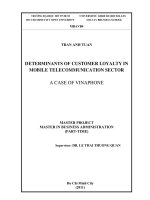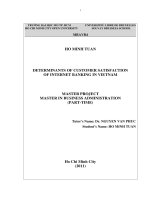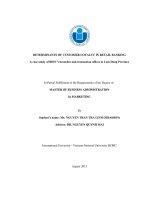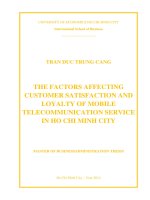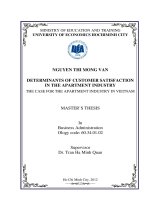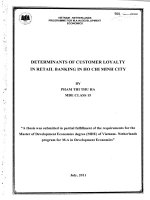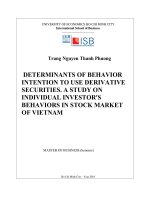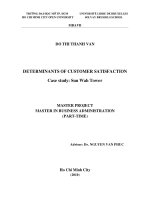Determinants of customer loyalty in mobile telecommunication sector A case of VinaphoneDeterminants of customer loyalty in mobile telecommunication sector A case of Vinaphone
Bạn đang xem bản rút gọn của tài liệu. Xem và tải ngay bản đầy đủ của tài liệu tại đây (1.2 MB, 88 trang )
TRƯỜNG ĐẠI HỌC MỞ TP.HCM
HO CHI MINH CITY OPEN UNIVERSITY
UNIVERSITEÙ LIBRE DE BRUXELLES
SOLVAY BRUSSELS SCHOOL
MBAVB4
TRAN ANH TUAN
DETERMINANTS OF CUSTOMER LOYALTY IN
MOBILE TELECOMMUNICATION SECTOR
A CASE OF VINAPHONE
MASTER PROJECT
MASTER IN BUSINESS ADMINISTRATION
(PART-TIME)
Supervisor:
DR. LE THAI THUONG QUAN
Ho Chi Minh City
(2011)
ii
STATEMENT OF ORIGINAL AUTHORSHIP
I certify that the substance of this thesis has not already been submitted for any degree
and is not currently being submitted for any other degree or qualification.
I also certify that, to the best of my knowledge, any help received in preparing this
thesis, and all sources used have been acknowledged in this thesis.
Tran Anh Tuan
March 5
th
, 2012
iii
ACKNOWLEDGEMENT
I owe a debt of gratitude to many people who helped me complete this thesis. I would like to
acknowledge the help of all.
First of all I would like to thank the Viet-Belgium Master program with all professors
and coordinators, especially Belgium professors who come from a far country and bring us
not only useful knowledge but also self-confidence and dreams. I also thank all my friends at
MBAVB4 for their contribution and support in class and real life. I wish you all the best in
your future.
Next, I own particular thank to my supervisor, Dr. Le Thai Thuong Quan, for his
valuable advice, recommendations and comments in earlier draft of my thesis.
I wish to thank Mr. Le Xuan Hien from Service Development Center of Vinaphone for
useful information about mobile telecommunication service in Vietnam, especially
Vinaphone context.
In the process of data collection for this research, many people contributed to the task
and I am particularly grateful for their contributions, especially Mr. Le Xuan Hien and his
colleagues from Vinaphone, Mr. Tran Dang Khoa and my colleagues from NEO company.
Finally, to my family, I would like to express my deepest gratitude to my beloved
parents who give me a great encouragement for everything I want to do. My loving thanks to
my wife and children for their love and support. This thesis is the dedicated gift for them all.
Tran Anh Tuan
March 5
th
, 2012
iv
SUPERVISOR’S COMMENTS
The topic has practical meaning and the author has successfully shown the ability to do
a marketing/behavioral research. For this, the author has conducted a customer survey and
used a very modern technique to analyze and test the hypothesis. In overall, the presentation
is clear and the thesis is up to the standard. I approve for the public presentation.
Le Thai Thuong Quan
v
ABSTRACT
This study evaluates and investigates the relationships between the quality service of
Vietnam’s mobile carrier, the customer satisfaction and customer loyalty. These
relationships were tested using a sample of 284 mobile users in HCM City. The result
indicates that the call quality and convenience of procedure and support are the major factor
that makes customers satisfied and loyal to mobile carrier. The switching cost of does not
affect customer loyalty. In addition, factors of customer age and education level and income
groups have significant difference on customer satisfaction through convenience of
procedure and customer support. Implications for managers and directions for future
research are also discussed.
vi
TABLE OF CONTENTS
STATEMENT OF ORIGINAL AUTHORSHIP ii
ACKNOWLEDGEMENT iii
SUPERVISOR’S
COMMENTS iv
ABSTRACT v
TABLE OF CONTENTS vi
LIST OF ABBREVIATIONS ix
LIST OF TABLES x
LIST OF FIGURES xi
Chapter 1 :
INTRODUCTION TO THE STUDY 1
1.1
Rationale of the study 1
1.2
Research objectives 2
1.2.1
Research questions 2
1.2.2
Research objectives 2
1.3
Methodology 2
1.4
Scope and Limitations 3
1.5
Implications of research 3
1.6
Structure of the study 4
1.7
Conclusions 4
Chapter 2 :
INTRODUCTION TO VIETNAM MOBILE SERVICE MARKET 5
2.1
Overview of Vietnam’s mobile telecom service market 5
2.2
Vinaphone’s profile 9
2.2.1
Brief of history 9
2.2.2
Vinaphone’s Strategy 10
2.2.3
Infrastructure and network coverage 11
2.2.4
Distribution and support system 11
2.2.5
Services and value-added services 12
2.2.6
Price structure & Promotion 13
2.2.7
Achievements 14
2.3
Conclusion 15
vii
Chapter 3 :
LITERATURE REVIEW 16
3.1
Definition of services 16
3.2
Perceived service quality and customer satisfaction 17
3.3
Customer loyalty 19
3.4
Switching barrier 21
3.5
The testing model and hypotheses 22
3.6
Conclusion 24
Chapter 4 :
RESEARCH METHODOLOGY & DESIGN 25
4.1
Research methodology 25
4.1.1
Research approach 25
4.1.2
Research processes 26
4.2
Research Design 27
4.2.1
Research model 27
4.2.2
Questionnaire 28
4.2.3
Data collection 30
4.3
Data analysis 31
4.3.1
Data analysis processes 31
4.3.2
Descriptive statistics analysis 31
4.3.3
Testing model and hypothesis checking 32
4.3.4
The effect of demographic characteristics 33
4.4
Conclusion 33
Chapter 5 :
DATA ANALYSIS AND FINDINGS 34
5.1
Descriptive analysis and findings 34
5.1.1
Data collecting result 34
5.1.2
Evaluation of perceived service quality, satisfaction and loyalty 37
5.1.3
Evaluation of switching barrier 40
5.2
Quantitative analysis and findings 41
5.2.1
Assessment of measurement scale 42
5.2.2
Factor analysis 44
5.2.3
Hypotheses and Testing model 45
5.3
The impact of demographic variables 49
5.3.1
T-test for the variable having two group 50
5.3.2
Testing for multiple groups variables 50
5.4
Conclusion 52
Chapter 6 :
CONCLUSIONS AND RECOMMENDATIONS 53
6.1
Conclusions related to research questions 53
6.1.1
Service quality measurement 53
viii
6.1.2
Factor of customer loyalty 54
6.1.3
Effect of demographics 54
6.2
Recommendations of the research study 54
6.2.1
Recommendations for Vietnamese mobile carrier 54
6.2.2
Recommendations for Vinaphone 55
6.3
Limitations and recommendation for further research 55
REFERENCES 57
APPENDIX 1: QUESTIONAIRES (VIETNAMESE) 59
APPENDIX 2: QUESTIONAIRES (ENGHLISH) 62
APPENDIX 3: FACTOR ANALYSIS 65
APPENDIX 4: DEMOGRAPHICS TEST 73
ix
LIST OF ABBREVIATIONS
Abbreviation Description
3G
Third-generation technology
ARPU
Average Revenue Per User
BTS
Base Transceiver Station
CDMA
Code Division Multiple Access
CFA
Confirmatory Factor Analysis
EFA
Exploratory Factor Analysis
GSM Global System for Mobile
GSO
General Statistics Office
MIC
Ministry of Information and Communications
SEM
Structural Equation Modeling
SPSS
Statistical Package for Social Science
VAS
Value-added Service
x
LIST OF TABLES
Table 3 - 1:
Theoretical mobile customer loyalty model 23
Table 4 - 1:
Variables definition and measurements 28
Table 5 - 1:
Statistics of respondent characteristics 35
Table 5 - 2:
Statistics towards mobile carriers (per cent of using) 36
Table 5 - 3:
Statistics on service quality, customer satisfaction and customer loyalty . 39
Table 5 - 4:
Statistics on switching barrier effect 41
Table 5 - 5:
Cronbach's alpha of the scale of the survey 42
Table 5 - 6:
List of factors 45
Table 5 - 7:
Path coefficients of the structural model 47
xi
LIST OF FIGURES
Figure 2 - 1:
Number of mobile phone subscriber 6
Figure 2 - 2:
Mobile phone subscribers per 100 inhabitants 7
Figure 2 - 3:
Basic mobile services revenue 7
Figure 2 - 4:
Vietnam’s mobile telecommunication market shares 8
Figure 2 - 5:
Asian churn rate vs. prepaid penetration in 2011 9
Figure 2 - 6:
Vinaphone revenues per year (Source: Vinaphone) 14
Figure 2 - 7:
Vinaphone active subscribers per year (Source: Vinaphone) 14
Figure 4 - 1:
Research processes 26
Figure 4 - 2:
Proposal research model 27
Figure 4 - 3:
Data analysis processes 31
Figure 5 - 1:
Unstandardized estimates of the SEM model 47
Figure 5 - 2:
The results of the SEM model 48
1
CHAPTER 1 :
INTRODUCTION TO THE STUDY
1.1
Rationale of the study
In recent years, Vietnam mobile telecommunication sector has made a boom in many
aspects, from the development of services and technologies to the growth of the market, of
the provider’s business and of the number of subscribers. Many new technologies have been
applied to Vietnam as GSM, CDMA and 3G. The newest technology of 4G is also being
tested. After 5 years from 2006 to 2011, the number of subscribers increate from 4.4 million
to 117.6 million. The increase of mobile subscribers help Vietnam gained the eighth position
in terms of mobile phone subscriber development density from ITU in 2010. Until now, the
mobile market has the participation of six providers with two of them are private company,
breaking the monopoly previously. The development of mobile telecommunication make the
service is considered a luxury become popular with people.
With above achievements, Vietnam mobile telecommunication still opens many
opportunities for suppliers. According the survey of MIC, the number of Vietnam mobile
users was over 30.23 million mobile users in total nearly 86 million inhabitants. It means the
market is still open with about 2/3 of the population, corresponding to over 50 million
people, not using mobile services.
Besides above achievements, Vietnam mobile market has faced many difficulties and
challenges. After a quick development, the number of new customers per month tends to
decline. With more providers, the market becomes more competitive. The price war has
made the ARPU decrease much lower than others countries. Specially, the ratio of customer
churn is over 10%, and this index is even higher in real. These difficulties forced the vendors
to find solutions to retain customers.
The academic researches show that problems of customer retention in mobile
telecommunication sector involve its service quality, customer satisfaction and customer
loyalty. To get the right solution, mobile carrier shall identify, measure level of the response
ò their services, determine the level of customer satisfaction, and identify the determinants of
customer loyalty, from which to find the appropriate solution for customer retention.
2
1.2
Research objectives
1.2.1 Research questions
Vinaphone is one of Vietnam mobile carriers, and it also faces the problems of
competitive environment and customer retention. The task of this research is to answer their
following management questions:
How do the customers of Vinaphone and other carriers perceive the service
quality of their provider? How much do they feel satisfy? How much do their
loyalty toward the operators.
What are determinants of customer loyalty in Vietnam mobile market?
What are the differences between customer behaviors toward loyalty base on their
demographic characteristics?
1.2.2 Research objectives
To answer the research questions mentioned previously, this study has the following
objectives:
To measure the perceived the service quality, customer satisfaction and customer
loyalty toward each mobile operators in Vietnam, especially Vinaphone
To find out the determinants of customer loyalty and to verify the model of
Vietnam mobile customers.
To find out the effect of demographic characteristics on customer loyalty, than
propose a guideline for customer segmentation of Vinaphone.
1.3
Methodology
This study is empirical research, designed to measure and identify factors effect
customer loyalty in mobile telecommunication sector in Vietnam, from which to propose a
guideline for the strategy of Vinaphone. The research carried out through two steps:
preliminary research and primary research. The preliminary research was conducted by using
3
secondary data and group discussion to build the measurement of mobile service quality and
the trend of customer churn. The primary research is implemented by quantitative
methodology with a survey and data analysis by SPSS and AMOS software.
The survey was chosen as a research technique in this study to measure and identify
the determinants of customer loyalty. The survey is carried out with the participation of
university students, customers in transaction with Vinaphone’s shop, and internet users who
use mobile phone. Descriptive analysis is applied to measure the perceived service quality of
mobile carriers. Cronbach’s alpha and Exploratory Factor Analysis (EFA) of SPSS software,
Confirmatory Factor Analysis (CFA) and SEM mode of AMOS software are used for factor
analysis, hypotheses checking and measure the demographic characteristics effect.
1.4
Scope and Limitations
The primary research carried out base one the measurements of previous research of
Kim M. K. et at. (2004) and Ky (2007). The customer loyalty is evaluated by group of
customer satisfaction and switching barrier variables. The measurement of the study has
limited observed variables. It is sure that the measurement could not reflect all the factors
that influence customer loyalty.
According to the original goals of the study, the survey’s participants are people who
are using mobile phones, and they are classified into groups according to the province of
Vietnam. Due to the limited resources, the study only focuses on students of universities and
customers on transaction with Vinaphone in Ho Chi Minh City. These limitations also affect
no less to the general results of the study.
1.5
Implications of research
The study brings practical implications for the mobile telecommunications service
provider. Firstly, the result help Vinaphone and others understand the customer evaluation
with their services, from which they build plan to improve their services. Secondly, the study
identifies the determinants of customer satisfaction and customer loyalty. It also point out the
effect of demographic characteristics on factors of customer loyalty. The above information
helps the mobile carriers to build customer loyalty and appropriate strategy for each
4
customer segment.
1.6
Structure of the study
This research is structured into 6 chapters. Chapter 1 introduces the research including
research background, research problem, research questions, research objectives and
methodology of the research. Chapter 2 provides an overview of Vietnam mobile
telecommunication service market and particularly the Vinaphone context. Chapter 3 make a
tour of literature review of customer loyalty in mobile telecommunication services. Chapter
4 discusses methodology utilized in the research. Chapter 5 analyses the data collected and
presents the findings of the research. Chapter 6 points out conclusions and the implications
of the research in the world of business administration.
1.7
Conclusions
This research measures and identifies factors effect customer loyalty in mobile
telecommunication sector in Vietnam. This research is designed as a combination of
descriptive and quantitative research in which a sample of 284 interviews of mobile users in
Ho Chi Minh City.
Gathered data will be processed by computer, using both SPSS and AMOS software.
Descriptive statistical techniques will be applied to measure the customer’s perception of
service quality of mobile carriers in Vietnam. Factors analysis and SEM model are built to
find the factors and their effect on customer loyalty (chapter 5). The conclusions related to
research question and recommendations for mobile carrier is presented in the final chapter
(chapter 6).
5
CHAPTER 2 :
INTRODUCTION TO VIETNAM
MOBILE SERVICE MARKET
2.1
Overview of Vietnam’s mobile telecom service market
In recent years, Vietnam’s mobile telecommunications service market has made a
great progress showing by the number of service providers as well as the number of
subscribers using the service. By the end of 2011, the market has the participation of six
service providers including Vinaphone (VNPT), Mobifone (VMS-VNPT), Viettel (Viettel
Group), S-Fone (SPT), Vietnamobile (Hanoi Telecom Corp.), E-Mobile (EVN Telecom) and
Beeline (Gtel) with 117.6 million mobile subscribers (Source: General Statistics Office).
In 1993, Mobifone was the first GSM mobile telephony services provider in Vietnam
and had been run under cooperation between Mobifone and Comvik, a subsidiary of
Millicom International Cellular SA (Sweden). After 3 years, Vinaphone was established as
the first 100 percent state-owned company in 1996. In July 2003, S-Fone joined the mobile
market and was the first CDMA technology. A short time later, Viettel mobile network was
founded in October 2004, and Viettel is a first military-run telecom company in Vietnam
with strong points of the army. After that, other mobile networks appeared one after another
include: E-mobile in May 2006, HT Mobile in January 2007 (change to Vietnamobile in
2009), and Beeline in July 2008.
At the beginning, Vietnam mobile carrier deployed both GSM and CDMA technology.
Three major networks, Mobifone, Vinaphone and Viettel use GSM, while S-Fone, HT
Mobile and E-Mobile use CDMA. After one year of operation, HT Mobile switched to GSM
technology and changed its name to Vietnamobile in April 2009. Until now, there is only S-
Fone and E-mobile using CDMA technology. E-mobile is acquired by Viettel in January
2011. Thus, in near future GSM is the ones dominates completely in Vietnam.
In general, the development of Vietnam has gone through three stages, including
development, growth and maturity stage. The development stage begins in 1993 to end in
2004 when three main operators (Vinaphone, Mobifone and Viettel) and one CDMA
6
operator (S-Fone) entered the market. During 10 year, the market reaches totally 4.4 millions
of mobile subscribers and operators took time to preparing for future by completing their
service infrastructures and expanding the network coverage.
The second stage begins in 2005 when the number of mobile subscriber exceeds the
number of fixed phone subscriber with the ratio 57% over 43%. At the end of 2006, the
number of subscriber was over 18 million, up threefold since 2004. After that, the ratio of
increased subscriber was over 2 digits each year and the revenue rose over 40% for many
years. At the end of 2010, the number of subscriptions was over 111 million, it was over 5
times of the number of subscribers in 2004. The Vietnamese mobile market continues to
expand with the new entrants, E-mobile (EVN Telecom), HT Mobile and Beeline. The
entrance of new players has increased competitiveness in the market. Cheaper service
prices and rapidly expanding coverage have made the market more accessible to the
subscribers, even to the low-income users. Prices have been cut off by years and are in
tendency to be adjusted more, allowing mobile services to penetrate into the low-income
population, attracting more potential users.
There were some signs that the mobile market in Vietnam are getting into the maturity
stage. One of the signs is the falling of the number of subscribers grows by year. From 2006
to 2008, the number of new customer increased more than 20 million each year, but this
number decrease to 17 million in 2010. At the end of 2011, the number of mobile subscribers
is 117.6 million, so the new subscribers were only 1.9 million, much smaller than previous
years.
Figure 2 - 1:
Number of mobile phone subscriber
7
Figure 2 - 2:
Mobile phone subscribers per 100 inhabitants
Figure 2 - 3:
Basic mobile services revenue
(Source: Vietnam ICT White book 2011)
Today, the mobile telecommunication market shares is quite stable with three majors,
military-run telecom group Viettel accounted for 36.72% of the market, followed by
Mobifone with 29.11% and Vinaphone with 28.71%. Other small providers, including S-
Fone, E-mobile (EVN Telecom), Vietnamobile and Beeline, accounted for only 5%. The
mobile market is more competitive now, so that customers could easily choose their
providers, and the operators will try to retain their subscribers because it will be difficult to
develop new ones.
8
Figure 2 - 4:
Vietnam’s mobile telecommunication market shares
(Source: Vietnam ICT White book 2011)
Besides the competitive environment and decrease in new subscribers, operators have
to face with the sharp fall in ARPU over the years. According to Business Monitor
International (BMI), the mobile ARPU in Vietnam averaged at $5 in 2010, down from $5.52
in 2009. The mobile ARPU reached US$6 in 2008 and $6.5 in 2007. It also predicted the
ARPU will fall to US$4.49 in 2011 before decreasing to US$3.51 by 2015. MIC reported
that Mobifone has had the largest ARPU in Viet Nam, followed by Vinaphone. Viettel
ranked third despite having the largest market share.
There are many reason of ARPU decline. One of the reasons relates to the impact of
the economic slowdown on customer spending patterns. Another more important one is the
competition in charge cuts, which were introduced by the leading mobile operators over
years. The fall in mobile ARPU is also determined by the amount of prepaid subscribers.
Vietnam mobile market has about 70%-80% of prepaid subscribers. A report of MIC in June
2008, this ratio is about 90% prepaid over 10% postpaid.
To improve mobile ARPU, an India’s telecommunication cooperation, IMImobile,
pointed out value-added services will increase mobile ARPU. The experience of developed
countries shows revenues gained from voice services will proceed to totally free for users,
but 85% of their revenue comes from services and information content. Vietnam’s mobile
carriers have deployed many services on 3G technology. With more than 12.8 million of 3G
subscribers (MIC, Jan 2012), mobile services promise to thrive in the future.
9
The last problem of mobile carrier is the switching rate. According to MIC, the churn
rate of mobile phone users is about 11%. The Research On Asia (ROA) Holdings, an
independent Tokyo-based market research and consulting company specializing in wireless
and mobile markets in Asia, reported that the churn rate of Vietnam is in the two tops of
Asian which surpasses 10%. Two source of information seems consistent to each other and
in accordance with the market.
Figure 2 - 5:
Asian churn rate vs. prepaid penetration in 2011
2.2
Vinaphone’s profile
2.2.1 Brief of history
In 1996, the company is established with the name GPC which the mission to manage
and exploit 3 services: GSM mobile services, Paging service (P) and Card-based phone
services (C). Paging network was stopped operating in September 2004 by VNPT due to the
fact that it was no longer suitable for the market after ten years in operation.
A subsidiary company of Vietnam Posts and Telecommunications Group, Vinaphone
was officially established on June 26, 1996 as a nationwide mobile phone network using
next generation and modern GSM technology, with an eye towards creating healthy
competition in Vietnam's mobile communication market. By the end of 2000, Vinaphone
had completed its coverage of nearly all residential areas, industrial zones, highways,
tourism spots and border-gates throughout the country.
10
Many popular new services such as prepaid mobile phone service and international
roaming have been launched. Vinaphone was the first mobile operator in Vietnam to launch
3G services in the country.
In 2006, Vietnam officially became the 150th member of the World Trade
Organization (WTO). The name GPC was changed into Vinaphone and the new logo was
introduced. The new logo was made of water-drop circles connecting to one another softly
but closely and meaningfully. The water-drops connecting to one another express the
connectivity and spreading, which are business characteristics of Vinaphone The image of
three connecting water-drops creates a stable and powerful posture (Source: Vinaphone
website).
2.2.2 Vinaphone’s Strategy
The vision of Vinaphone is to be the leading mobile network in Vietnam and stays
close anywhere with our customers. Their vision also shows in the slogan “Available
everywhere”. To bring the vision into reality, Vinaphone established their missions are
trying their best to apply advance telecom technologies effectively, expanding their mobile
network anywhere and making make a great contribution to the socio-economic
developments of Vietnam.
Higher than the vision, Vinaphone desired to contributes values toward future of
community – human value, communication value and Vietnamese spiritual value. First, the
best value that Vinaphone want to deliver is human value by bringing the best services to our
customers, upgrading material and spiritual life of our employees, making interest to our
partners and making contribution to create benefits for the whole community. All is
"because of human, toward the human and among human being”. Then, the wide
telecommunications network coverage allows people living everywhere in Vietnam to
connect easily with each other and to bring them closely together by sharing experience,
emotion, success and knowledge. Finally, Vinaphone is the pioneer in expanding mobile
information in remote regions in Vietnam. We are doing business to provide good services in
order to promote local socio-economic developments, not just for profit only.
11
2.2.3 Infrastructure and network coverage
To be the first state-owned mobile service provider, Vinaphone was substantial
infrastructure investment to meet the target of nationwide coverage. By the end of 2011,
Vinaphone has 23.500 base transceiver stations (BTS) nation-wide, a mobile infrastructure
with more than 50 million account capacity. Its Short Message System is considered the
largest system in Vietnam with the bandwidth of 30 million messages per hour. Vinaphone
network coverage is regarded as the second after Viettel (50,000 BTS) (Source: MIC
website)
Upon introduction of 3G services, Vinaphone is the first mobile carrier deployed 3G
services national wide. In 2009, Vinaphone had installed the number of 6,000 BTS and
expanded to 10,000 BTS by the end of 2011. Comparing with 17,000 3G BTS of Viettel,
Vinaphone has gotten the second position in 3G services providers.
2.2.4 Distribution and support system
Vinaphone has three centers with the task of management, operation, and service
development corresponding with three regions of Vietnam: the Northern, the center and the
southern. Each center has collaborated with 64 provincial VNPT companies to provide
services. Along with the cooperation of 64 provincial VNPT companies, each province has
at least one transaction office, big city like Ho Chi Minh City and Ha Noi has nearly 20
points. Totally, Vinaphone has transaction office nationwide with more than 200 transaction
office. These transaction points are also the supporting point of Vinaphone.
Besides the official transaction office, Vinaphone has thousand of retailers which is
developed by each provincial VNPT, example Ha Noi VNPT has developed the retail system
with 5,400 retail points.
In term of support system, Vinaphone developed three supporting system, include
voice system (hotline), website and transaction office. Voice system consist three support
lines as 9191, 9192 and 18001091. The first one is consultancy service for national
customers, the second line is consultancy service for international customers, and the last one
includes automatic answering system and manual answering system to support direct sales
12
channel, urgent requests for cutting and settle claims in the process of consultancy.
2.2.5 Services and value-added services
Vinaphone offers the basic services including voice and SMS between subscribers.
Voice service includes prepaid, postpaid, long-term prepaid, 356 day prepaid services which
depend on payment type.
Besides the basic services, Vinaphone is considered as the leader in value-added
service (VAS) provider. The VAS services are divided into following catalogues:
Voice VAS service include: short dialing, international call, international roaming,
national roaming, call forwarding, call restriction, call holding, call waiting, voice
mail, fax data, calling line identification, calling line identification presentation,
Internet services: Mobile internet for mobile phone, ezCOM for USB 3G
Entertainment service: share & download game, image, ringtune, video, :
Ringtunes, Vshare, 9292 , Linh Trieu Binh Ca VinaBox, FunTalk, VStore,
Chacha, Vclip, V-live, Lottery service
Information services : 9108, VinaStock, Vnsport, Infoplus, Infor360, promotion
information searching
Utilities services include: MMS, MCA, CallMeBack, Data safe, Call block,
EZmail, Nokia Chat & Push maill
Value-added services: Music Gift, Say2Send, Voicemail
Payment services include: Advance Payment, EZpay, 2Friends, Topup, E-Topup,
E-load, Momo, Smart Topup,
SMS to operator: 996, 997, 8XXX, 1900XXXX
Being the leader in 3G services, Vinaphone has deployed many 3G services, include:
Video Call (call seeing the picture between the subscribers of VinaPhone), Mobile Camera
(live view image status of intersections), advanced entertainment services such as Mobile
TV (watch live TV channel 15 on your mobile), and the 3G Portal (the world of information
13
and entertainment on your mobile phone).
In 2009, Vinaphone joined the Conexus Mobile Alliance to develop and enhance
international roaming and coorperate mobile services across Asian. This coorperation bring
the great opportunities for Vinaphone subscribers to use cheap and convinent roaming and
VAS services in future.
2.2.6 Price structure & Promotion
Base on two type of payment, Vinaphone has a reasonable and flexible price structure
for users. Firstly, postpaid starts when you pay a registration. Then you will pay monthly
subscription fee and the charge base on your monthly usage. Vinaphone also proposes some
bill packages that you could choose, basic package for every on use postpaid subscription,
colleague package for group of student who talk to each other much, family package for
family members. You could select the individual package which set a fixed payment per
month. Most postpaid packages are cheaper than the basic ones.
Secondly, prepaid brings more conveniences to customers, especially young customers
who have the need to use mobile phone in a short time and do not like complicated
registration procedures. It is also suitable for organizations which want to control calling fee
of their employees. In spite of convenience, prepaid charged for each call will be higher
compared with postpaid.
Prepaid users can choose any kind of cards: Vinacard with many level of value from
10,000 VND to 300,000VND; Vinadaily alllows users pay daily subscription charge,
Vinatext for sending SMS only, etc For each kind of prepaid payment, there is a specific
tariff for it and user can easily choose one of them for herself.
In term of VAS services, each service has its own rate. You only have to pay the
services you registered and the charge will be pay immediately (prepaid) or accumulated into
the monthly bill (postpaid).
Besides a reasonable price structure, Vinaphone offered promotion in some special
holidays or special occasions like launching new services. The promotions mainly offered to
14
prepaid customers by giving more value of card, add more using days, free charge for some
services, etc With postpaid users, promotions usually giving more time to use some
services, discount amount of time or money. Vinaphone has point-counting mechanism for
customer care. Awarding points of customers are calculated based on the service use time,
charge arisen, package subscribed (for postpaid subscribers) or value of the card (for prepaid
subscribers). Accumulated points of customers can be converted into gifts under regulations
of the program.
2.2.7 Achievements
Being the pioneer of applied technology and development services, Vinaphone
has achieved much successful in both revenue and network penetration. The revenue
has increase stable from 2006 to 2010, but tend to go down in 2011. Specially, the
revenue of 2011 consists 40% of non-voice services (Source: Vinaphone). This shows
the downward trend of the mobile market.
Figure 2 - 6:
Vinaphone revenues per year (Source: Vinaphone)
Figure 2 - 7:
Vinaphone active subscribers per year (Source: Vinaphone)

